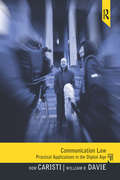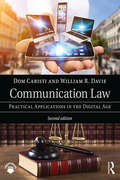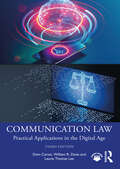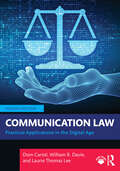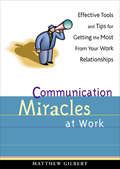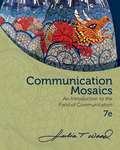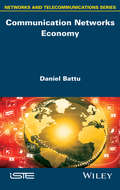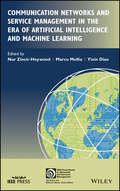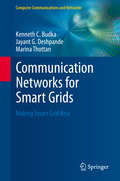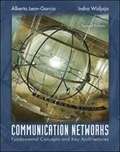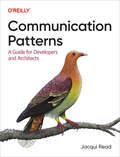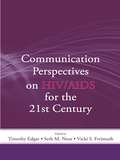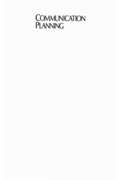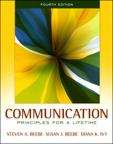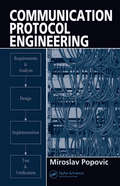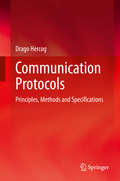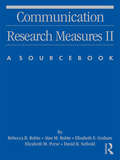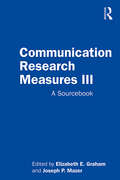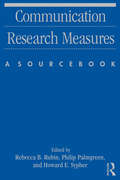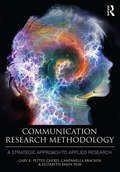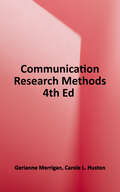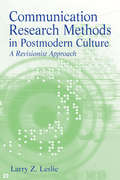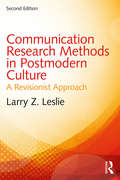- Table View
- List View
Communication Law
by Michael Cavanaugh Dominic G Caristi William R DavieDebuting in its first edition, Communication Law is an engaging and accessible text that brings a fresh approach to the fundamentals of mass media law. Unique in its approach and its visually attractive design, this text differentiates itself from other current texts on the market while presenting students with key principles and landmark cases that establish and define communication law and regulation, providing a hands-on learning experience.
Communication Law: Practical Applications in the Digital Age
by William R Davie Dom CaristiNow in its second edition, Communication Law: Practical Applications in the Digital Age is an engaging and accessible text that brings a fresh approach to the fundamentals of mass media law. Designed for students of communication that are new to law, this volume presents its readers with key principles and emphasizes the impact of timely, landmark cases on today’s media world, providing an applied learning experience. This new edition offers a brand new chapter on digital media law, a wealth of new case studies, and expanded discussions of current political, social, and cultural issues.
Communication Law: Practical Applications in the Digital Age
by William R Davie Dom Caristi Laurie Thomas LeeThis fully revised third edition brings a fresh approach to the fundamentals of mass media and communication law in a presentation that undergraduate students find engaging and accessible. Designed for students of communication that are new to law, this volume presents key principles and emphasizes the impact of timely, landmark cases on today’s media world, providing an applied learning experience. This new edition offers expanded coverage of digital media law and social media, a wealth of new case studies, expanded discussions of current political, social, and cultural issues, and new features focused on ethical considerations and on international comparative law. Communication Law serves as a core textbook for undergraduate courses in communication and mass media law. Online resources for instructors, including an Instructor’s Manual, Test Bank, and PowerPoint slides, are available at: www.routledge.com/9780367546694
Communication Law: Practical Applications in the Digital Age
by Dom Caristi Laurie Thomas Lee William R. DavieThis fully revised 4th edition brings a fresh approach to the fundamentals of mass media and communication law in an engaging and accessible way, keeping legal jargon to a minimum and highlighting real-life examples of legal conflicts.Designed for students of communication that are new to law, this volume presents key principles and emphasizes the impact of timely, landmark cases on today’s media world. Providing an applied learning experience, this new edition offers expanded coverage of telecommunications, digital media law, and social media. It presents discussions of contemporary political, social, and cultural issues such as artificial intelligence, surveillance, cybersecurity, revenge porn, deepfakes, and disinformation campaigns. To encourage critical thinking, chapters include “From the Trenches” vignettes written by practitioners, “Global View” pieces comparing U.S. status to that in other countries, and “Ethical Dilemmas” ideal for class discussion.Communication Law serves as a core textbook for undergraduate courses in communication and mass media law.Online resources for instructors, including an Instructor’s Manual, Test Bank, PowerPoint slides, and Timelines are available at: www.routledge.com/9781032612980.
Communication Matters (Third Edition)
by Kory FloydCommunication Matters: Effective communicators are made, not born. We all communicate, all the time. Consequently, many of us believe we're experts, that good communication is based on personal instincts. In this highly interactive program, students learn to think through how they communicate rather than rely solely on their instincts. They develop the skills needed to become effective communicators. Communication Matters prompts students to question their assumptions, challenges them to think critically about why and how they communicate in the ways that they do, and provides solid tools and takeaways that students can employ to communicate effectively even in difficult situations. Through an adaptive reading experience with SmartBook, student videos for public speaking, and dynamic online activities, Communication Matters urges students to consider which choices are likely to be effective and which less so.
Communication Miracles at Work: Effective Tools and Tips for Getting the Most From Your Work Relationships
by Matthew GilbertCommunication Miracles at Work is about experiencing breakthrough moments of connectedness and understanding with co-workers, managers, staff members, and clients. Developed out of Matthew Gilbert's experience as an employee, communication consultant, manager, and facilitator, Communication Miracles at Work will help readers develop effective communication and relationship-building skills for achieving workplace harmony. Topics include the "corporate culture" and how it enhances or hinders the ability of people to get along, the role of stress in ineffective communication, issues of gender in talking and listening, and how to use good communication in everyday situations. Readers are carefully guided toward seeing their own personal obstacles around communicating and are given effective tools on how to make almost any workplace encounter an opportunity for personal and spiritual growth. This book is for anyone who wants to have a better day-to-day experience at work, reaching out to people wherever they are on the corporate ladder, from those just entering the workforce to more experienced workers to managers and CEOs.
Communication Mosaics: An Introduction to the Field of Communication, Seventh Edition
by Julia T. WoodCOMMUNICATION MOSAICS: AN INTRODUCTION TO THE FIELD OF COMMUNICATION, Seventh Edition, combines the author's signature first-person narrative style and popular student commentaries with thoroughly up-to-date research, theories, and technological information to provide both an overview of the field and a practical guide you can immediately use to improve your personal, professional, and public communication skills. By beginning with introductions to the basic processes and skills central to all communication contexts and then moving on to how we apply these aspects of communication in specific contexts such as interpersonal and public speaking, the text shows you the importance of developing your communication skills and gives you the hands-on tools you need to become a more effective communicator.
Communication Networks Economy
by Daniel BattuThe rapid economic expansion of the Western countries during the XX century has favored the idea that Economy growth could be mathematically linked to the manufacturing processes and to a correct management and distribution of the common tools necessary in the social life. A specific geographical management and an adequate telecom framework are necessary for the success of the economic activities. Conversely, the telecom network should answer to the needs of the national economy. On these two basic topics, several errors have been expressed and can lead to non-useful investments.
Communication Networks and Service Management in the Era of Artificial Intelligence and Machine Learning (IEEE Press Series on Networks and Service Management)
by Nur Zincir-HeywoodCOMMUNICATION NETWORKS AND SERVICE MANAGEMENT IN THE ERA OF ARTIFICIAL INTELLIGENCE AND MACHINE LEARNING Discover the impact that new technologies are having on communication systems with this up-to-date and one-stop resource Communication Networks and Service Management in the Era of Artificial Intelligence and Machine Learning delivers a comprehensive overview of the impact of artificial intelligence (AI) and machine learning (ML) on service and network management. Beginning with a fulsome description of ML and AI, the book moves on to discuss management models, architectures, and frameworks. The authors also explore how AI and ML can be used in service management functions like the generation of workload profiles, service provisioning, and more. The book includes a handpicked selection of applications and case studies, as well as a treatment of emerging technologies the authors predict could have a significant impact on network and service management in the future. Statistical analysis and data mining are also discussed, particularly with respect to how they allow for an improvement of the management and security of IT systems and networks. Readers will also enjoy topics like: A thorough introduction to network and service management, machine learning, and artificial intelligence An exploration of artificial intelligence and machine learning for management models, including autonomic management, policy-based management, intent based management, and network virtualization-based management Discussions of AI and ML for architectures and frameworks, including cloud systems, software defined networks, 5G and 6G networks, and Edge/Fog networks An examination of AI and ML for service management, including the automatic generation of workload profiles using unsupervised learning Perfect for information and communications technology educators, Communication Networks and Service Management in the Era of Artificial Intelligence and Machine Learning will also earn a place in the libraries of engineers and professionals who seek a structured reference on how the emergence of artificial intelligence and machine learning techniques is affecting service and network management.
Communication Networks for Smart Grids: Making Smart Grid Real (Computer Communications and Networks)
by Marina Thottan Kenneth C. Budka Jayant G. DeshpandeThis book presents an application-centric approach to the development of smart grid communication architecture. The coverage includes in-depth reviews of such cutting-edge applications as advanced metering infrastructure, distribution automation, demand response and synchrophasors. Features: examines a range of exciting utility applications made possible through smart grid evolution; describes the core-edge network architecture for smart grids, introducing the concept of WANs and FANs; explains how the network design paradigm for smart grids differs from that for more established data networks, and discusses network security in smart grids; provides an overview of communication network technologies for WANs and FANs, covering OPGW, PLC, and LTE and MPLS technology; investigates secure data-centric data management and data analytics for smart grids; discusses the transformation of a network from conventional modes of utility operation to an integrated network based on the smart grid architecture framework.
Communication Networks: Fundamental Concepts and Key Architectures (Second Edition)
by Alberto Leon-Garcia Indra WidjajaThis work is designed for introductory one-semester or one-year courses in communications networks in upper-level undergraduate programmes. The Big Picture is presented with a discussion of network-based applications and services such as the WWW, e-mail and home video entertainment. The essential functions in the operation of a network are discussed, and examples are given that motivate the notion of layering, and the OSI Reference model. Exposing students to the big picture should help them learn and apply the information more readily. Network performance is introduced as an integral part of network design and operation.
Communication Pathways
by Joseph M. Valenzano III Melissa Broeckelman-Post Erin ParcellFrom the authors of The Speaker and The Speaker's Primer comes an innovative new textbook that covers hybrid communication course curriculum in an approachable way. Communication Pathways introduces to the market a handbook-style approach to the hybrid course, with concise chapters that emphasize communication theory. The authors chose to organize content around a communication-centric theme: dialogue. The first section of the text dedicates an entire chapter to the subject, unpacking the concept for students; the authors further incorporate and explicate dialogic communication as it applies to subsequent chapter concepts. This theme is unique to the text and is a central element of what the authors aim to accomplish: create competent, dialogic communicators who know how to advocate ideas civilly, explain complicated subjects, and disagree without being disagreeable in a variety of interactive settings.
Communication Patterns: A Guide for Developers and Architects
by Jacqui ReadHaving a great idea or design is not enough to make your software project succeed. If you want stakeholders to buy into your design and teams to collaborate and contribute to the vision, you also need to communicate effectively. In this practical book, author Jacqui Read shows you how to successfully present your architecture and get stakeholders to jump on board.Misunderstanding and lack of buy-in leads to increasing costs, unmet requirements, and an architecture that is not what you intended. Through constructive examples and patterns, this book shows you how to create documentation and diagrams that actually get the message across to the different audiences you'll face.This book shows you how to:Design diagrams and documentation appropriate to your expected audience, intended message, and project stageCreate documentation and diagrams that are accessible to those with varying roles, needs, or disabilitiesMaster written, verbal, and nonverbal communication to succeed in technical settingsApply the communication patterns presented in this book in real-world projects and software designsCommunicate and collaborate with distributed teams to successfully design and document software and technical projects
Communication Perspectives on HIV/AIDS for the 21st Century (Routledge Communication Series)
by Seth M. Noar Timothy Edgar Vicki S. FreimuthReflecting the current state of research into the communication aspects of HIV/AIDS, this volume explores AIDS-related communication scholarship, moving forward from the 1992 publication AIDS: A Communication Perspective. Editors Timothy Edgar, Seth M. Noar, and Vicki S. Freimuth have developed this up-to-date collection to focus on today’s key communication issues in the HIV/AIDS epidemic. Chapters herein examine the interplay of the messages individuals receive about AIDS at the public level as well as the messages exchanged between individuals at the interpersonal level. Acknowledging how the face of HIV/AIDS has changed since 1992, the volume promotes the perspective that an understanding of effective communication through both mediated and interpersonal channels is essential to winning the continued battle against AIDS. Issues addressed here include: Social stigma associated with the disease, social support and those living with HIV/AIDS, and the current state of HIV testing Parent–child discussions surrounding HIV/AIDS and safer sexual behavior, and cultural sensitivity relating to developing HIV prevention and sex education programs The effectiveness of health campaigns to impact attitudes, norms, and behavior, as well as the current state of entertainment education and its ability to contribute to HIV prevention News media coverage of HIV/AIDS and the impact of the agenda-setting function on public opinion and policy making Health literacy and its importance to the health and well-being of those undergoing HIV treatment. The role of technological innovations, most notably the Internet, used for both prevention interventions as well as risky behavior The volume also includes exemplars that showcase the diversity of approaches to health communication used to combat the HIV/AIDS epidemic. These cases include interpersonal and mass communication mediums; traditional along with new media and technology; research by academics and practitioners; individual as well as community-based approaches; work based in the United States and internationally; and campaigns directed at at-risk, HIV- positive, as well as general populations. With new topics, new contributors, and a broadened scope, this book goes beyond a revision of the 1992 volume to reflect the current state of communication research on HIV/AIDS across key contexts. It is designed for academics, researchers, practitioners, and students in health communication, health psychology, and other areas of AIDS research. As a unique examination of communication research, it makes an indelible contribution to the growing knowledge base of communication approaches to combating HIV/AIDS.
Communication Planning: An Integrated Approach
by Sherry Devereaux FergusonThe nature of the communicator's job has changed dramatically over the last decade. While communicators still prepare speeches, press releases and articles for corporate magazines, they are now being asked to perform managerial duties such as planning, consulting stakeholders and advising CEO's and vice presidents. Communication Planning focuses on these additional responsibilities and examines the role of integrated planning in modern organizations. Sherry Ferguson's comprehensive study includes the theoretical foundations of communication planning and strategic approaches to planning for issues management.
Communication Principles for a Lifetime (4th edition)
by Susan J. Beebe Steven A. Beebe Diana K. IvyThe book provides readers with theory and skills in a manner that helps them apply what they've learned throughout their lives. Understanding that the challenge in communication is learning the myriad of skills, principles, and theories without being overwhelmed, Beebe, Beebe, and Ivy emphasize five key principles of communication throughout their book.
Communication Protocol Engineering
by Miroslav PopovicAs embedded systems become more and more complex, so does the challenge of enabling fast and efficient communication between the various subsystems that make up a modern embedded system. Facing this challenge from a practical standpoint, Communication Protocol Engineering outlines a hands-on methodology for developing effective communication protocols for large-scale systems.A Complete RoadmapThis book brings together the leading methods and techniques developed from state-of-the-art methodologies for protocol engineering, from specification and description methods to cleanroom engineering and agile methods. Popovic leads you from conceptualization of requirements to analysis, design, implementation, testing, and verification. He covers the four main design languages: specifications and description language (SDL); message sequence charts (MSCs); tree and tabular combined notation (TTCN); and unified modeling language (UML).Practical Tools for Real SkillsFully illustrated with more than 150 figures, this guide also serves as a finite state machine (FSM) library programmer's reference manual. The author demonstrates how to build an FSM library, explains the components of such a library, and applies the principles to FSM library-based examples.Nowhere else are the fundamental principles of communication protocols so clearly and effectively applied to real systems development than in Communication Protocol Engineering. No matter in what stage of the process you find yourself, this is the ideal tool to make your systems successful.
Communication Protocols: Principles, Methods and Specifications
by Drago HercogThis book provides comprehensive coverage of the protocols of communication systems. The book is divided into four parts. Part I covers the basic concepts of system and protocol design and specification, overviews the models and languages for informal and formal specification of protocols, and describes the specification language SDL. In the second part, the basic notions and properties of communication protocols and protocol stacks are explained, including the treatment of the logical correctness and the performance of protocols. In the third part, many methods for message transfer, on which specific communication protocols are based, are explained and formally specified in the SDL language. The fourth part provides for short descriptions of some specific protocols, mainly used in IP networks, in order to acquaint a reader with the practical use of communication methods presented in the third part of the book. The book is relevant to researchers, academics, professionals and students in communications engineering.Provides comprehensive yet granular coverage of the protocols of communication systems Allows readers the ability to understand the formal specification of communication protocolsSpecifies communication methods and protocols in the specification language SDL, giving readers practical tools to venture on their own
Communication Research Measures II: A Sourcebook (Routledge Communication Series)
by Rebecca B. Rubin Alan M Rubin Elizabeth M. Perse David Seibold Elizabeth E. GrahamExpanding and building on the measures included in the original 1994 volume, Communication Research Measures II: A Sourcebook provides new measures in mass, interpersonal, instructional, and group/organizational communication areas, and highlights work in newer subdisciplines in communication, including intercultural, family, and health. It also includes measures from outside the communication discipline that have been employed in communication research. The measures profiled here are "the best of the best" from the early 1990s through today. They are models for future scale development as well as tools for the trade, and they constitute the main tools that researchers can use for self-administered measurement of people's attitudes, conceptions of themselves, and perceptions of others. The focus is on up-to-date measures and the most recent scales and indexes used to assess communication variables. Providing suggestions for measurement of concepts of interest to researchers; inspiring students to consider research directions not considered previously; and supplying models for scale developers to follow in terms of the work necessary to produce a valid and reliable measurement instrument in the discipline, the authors of this key resource have developed a significant contribution toward improving measurement and providing measures for better science.
Communication Research Measures III: A Sourcebook (Routledge Communication Series)
by Elizabeth E. Graham Joseph P. MazerBuilding on the measures included in the original 1994 volume and subsequent 2009 volume, Communication Research Measures III: A Sourcebook extends its coverage of measurement issues and trends across the entire communication discipline. Volume III features entirely new content and offers an assessment of new measures in mass, interpersonal, instructional, group, organizational, family, health, and intercultural communication and highlights work in emergent subdisciplines in communication, including social media and new communication technologies, sports communication, and public relations. The “best of the best” from 2009 through today, the profiled research measures in Volume III serve as models for future scale development and constitute the main tools that researchers can use for self-administered measurement of people’s attitudes, conceptions of themselves, and perceptions of others. This book is ideal for undergraduate and graduate courses that emphasize quantitative research methods, measurement, and/or survey design across communication studies disciplines.
Communication Research Measures: A Sourcebook (Routledge Communication Series)
by Rebecca B. Rubin Howard E. Sypher Philip PalmgreenThe development of communication as a discipline has resulted in an explosion of scales tapping various aspects of interpersonal, mass, organizational, and instructional communication. This sourcebook brings together scales that measure a variety of important communication constructs. The scales presented are drawn from areas of interpersonal, mass, organizational, and instructional communication--areas in which the use of formal, quantitative scales is particularly well developed. Communication Research Measures reflects the recent important emphasis on developing and improving the measurement base of the communication discipline. It results in an equal amount of labor saved on the part of the scholars, students, and practitioners who find this book useful, and it contributes in a significant way to research efforts.Originally published by Guilford Press in 1994, now available from Routledge.
Communication Research Methodology: A Strategic Approach to Applied Research
by Cheryl Campanella Bracken Elizabeth B. Pask Gary PetteyThis introduction to communication research methods takes the student from the conceptual beginnings of a research project through the design and analysis. Emphasizing the correct questions to ask and how to approach the answers, authors Gary Petty, Cheryl Campanella Bracken, and Elizabeth Babin approach social science methods as a language to be learned, requiring multiple sessions and reinforcement through practice. They explain the basics of conducting communication research, facilitating students’ understanding of the operation and roles of research so that they can better critique and consume the materials in their classes and in the media. The book takes an applied methods approach, introducing students to the conceptual elements of communication science and then presenting these elements in a single study throughout the text, articulating the similarities and differences of individual methods along the way. The study is presented as a communication campaign, involving multiple methodologies. The approach highlights how one method can build upon another and emphasizes the fact that, given the nature of methodology, no single study can give complete answers to our research questions. Unique features of the text: It introduces students to research methods through a conceptual approach, and the authors demonstrate that the statistics are a tool of the concepts. It employs an accessible approach and casual voice to personalize the experience for the readers, leading them through the various stages and steps. The presentation of a communication campaign demonstrates each method discussed in the text. This campaign includes goals and objectives that will accompany the chapters, demonstrates each individual methodology, and includes research questions related to the communication campaign. The tools gained herein will enable students to review, use, understand, and critique research, including the various aspects of appropriateness, sophistication and utility of research they encounter.
Communication Research Methods
by Gerianne Merrigan Carole L. HustonIdeal for research methods courses covering multiple methodologies, Communication Research Methods is the only text that uses a research-as-argument approach to help students not only become more effective researchers, but more insightful consumers of research. Merrigan and Huston treat communication research comprehensively, discussing a broad range of traditional and contemporary methods and considering ethics in designing, conducting, and reporting research. NEW TO THIS EDITION The claims, data, and warrants chapters found in prior editions have been replaced with two new chapters that contextualise research arguments for quantitative social science (Ch. 4) and interpretive/critical research (Ch.11)A new chapter on interviews and focus groups (Ch. 12) will improve students' abilities to conduct interviews and code evidence based on repetition, recurrence, and forcefulness The ethics chapter (Ch. 3) now includes links to the ethical codes of conduct for 10 professional associations relevant to communication researchers in academia and industry Conversation Analysis (Ch. 10) and Discourse Analysis (Ch. 14), have been separated to more clearly represent the paradigmatic differences in those ways of studying language-in-use The chapter titles for all chapters in Parts II and III have been extended to help students more quickly compare those methods, and the text has been reorganised to match the first edition's order of paradigms All chapters include updated examples and more links to industry research. KEY FEATURES Each chapter begins with a short, reader-friendly introduction and student learning outcomes entitled 'What Will You Get from this Chapter? 'Shows students how research skills will matter in their roles at work, as consumers, parents, and voters, in healthcare and community contexts during school and after graduation Highlights the role of different methodologies for making different types of research arguments. This title is available as an eBook. Visit Vital Source for more information or to purchase.
Communication Research Methods in Postmodern Culture
by Larry Z LeslieCommunication Research Methods in Postmodern Culture explores communication research from a postmodern perspective while retaining key qualitative and quantitative research methods. The author uses easy-to-understand language to incorporate new research methods inspired by contemporary culture and includes review questions and suggested activities designed to help readers understand and master communication research. The blend of new and traditional methods creates a book appropriate to the study of communication in an increasingly complex cultural environment.
Communication Research Methods in Postmodern Culture: A Revisionist Approach
by Larry Z. LeslieThe second edition of Communication Research Methods in Postmodern Culture continues to explore research from a postmodern perspective. Typical qualitative and quantitative research methods are adjusted to fit the needs of contemporary culture. Each chapter is updated with new information and fresh examples. Included in the second edition is a new chapter on Internet and social media research. The author uses straightforward and easy-to-understand language. Both individual and group projects are among the suggested activities. This book is important for the study of communication in a changing political, social, economic, and technological environment.
